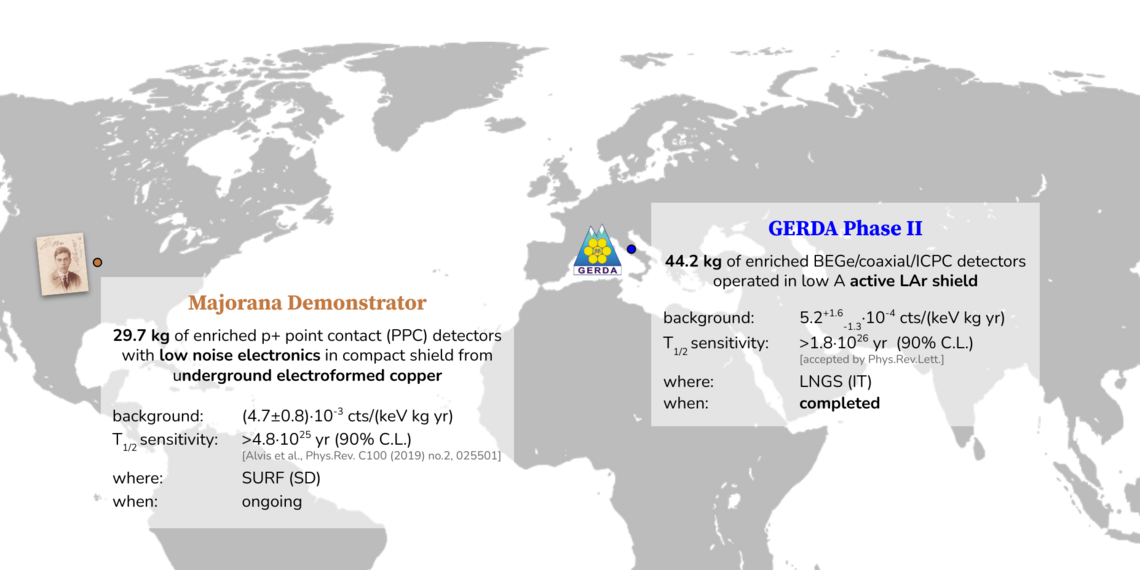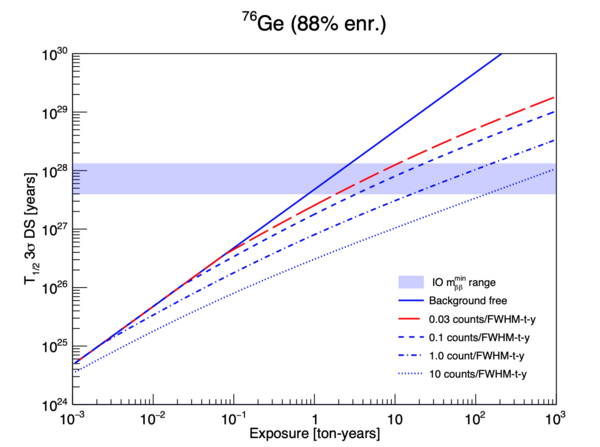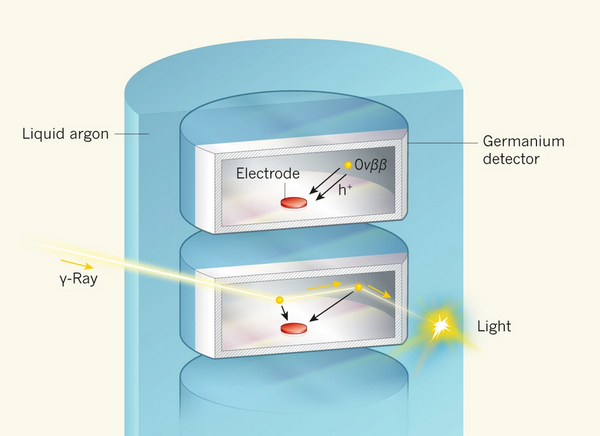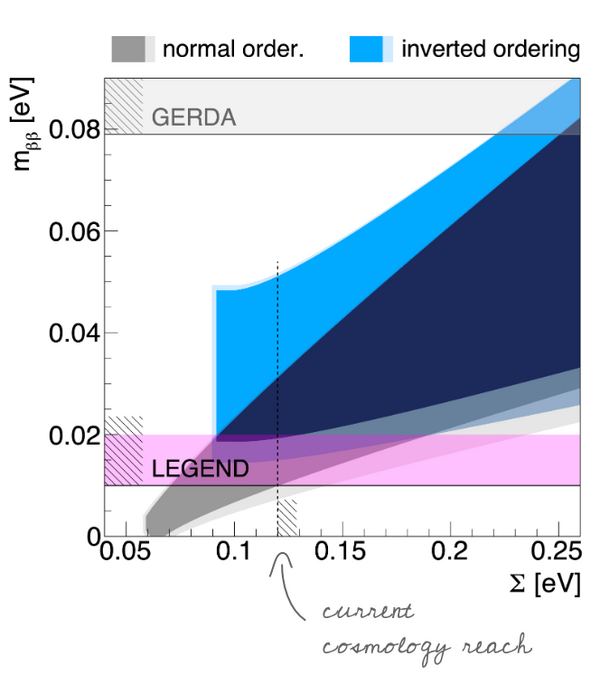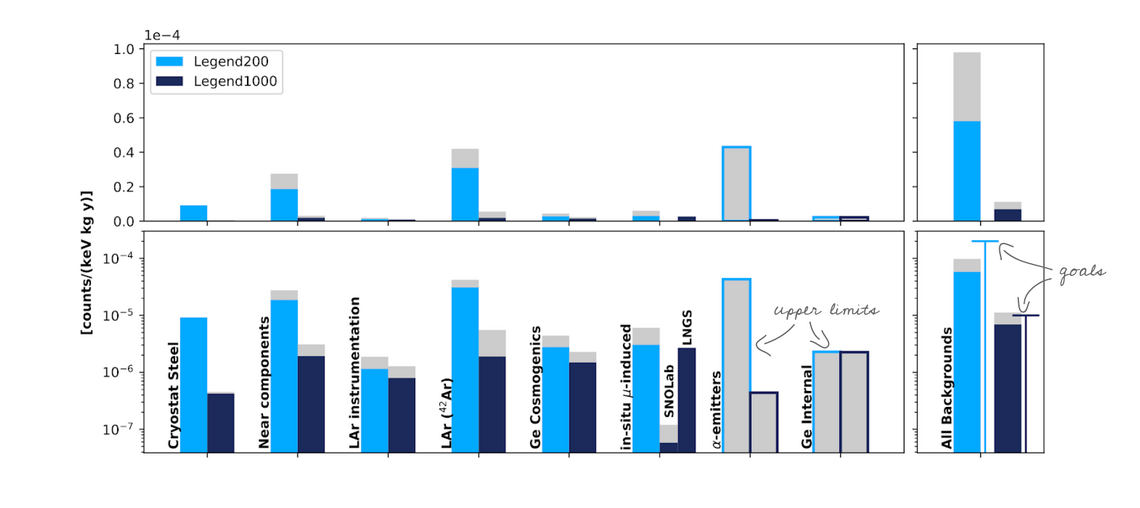LEGEND prospects
Ultra-low well-understood background and highest detection efficiency pave the road towards the detection of neutrinoless double beta decay. For this goal, an outstanding sensitivity is key.
A good sensitivity is the result of a high experimental exposure (the amount of watched nuclei) and no background (being able to only observe the nuclei decay). The exposure is defined as the product of the mass of active isotope and the measuring time. No background equals the experiment being able to recognize the electron peak at the end of the electron energy spectrum. The better the energy resolution of the detectors, the narrower the search region δE gets.
These three main parameters allow determining the reaching potential of the experiment and its sensitivity:
- the mass M of the relevant isotope (76Ge in our case),
- the data-taking time T,
- and the background index B (in units of cts/(keV·kg·yr))
at the relevant energy range δE near Qββ, where the 0νββ decay signal peak is expected.
One of the most commonly considered mechanisms for the neutrinoless process involves the exchange of a virtual Majorana neutrino. Considering this scenario, the decay rate (Γ0ν) is proportional to the square of a mass called effective Majorana neutrino mass mββ, which is a coherent sum of the three neutrino mass states.
It is convention for 0νββ decay experiments to report their sensitivity in therms of the half-life1 τ½, which is related to the mββ, M, B and T in the following way:
|
This indicates that both a large mass and almost-zero background expectation are paramount. A high sensitivity experiment will need large mass and the minimal background to operate in the “background-free” regime. Being LEGEND-200 comissioned in the GERDA infrastructure, where the zero-background conditions in the region of interest were achieved, will also reach this background limit.
Zero-background experiments with such sensitivities, like the LEGEND experiment projects, offer the best scaling in sensitivity with increasing exposure and make an excellent candidate to pioneer the search for the 0νββ decay.
The first stage of the experiment, LEGEND-200 is currently taking physics data since eraly 2023. The intended background index is 10−4 cts/(keV kg yr) and will allow reaching 1027 yr discovery sensitivity within 5 yr lifetime.
3-σ discovery sensitivity
► Background expectations
In both MAJORANA and GERDA, the dominant background comes from the elements surronding and holding the detectors; copper holders, electronics, screws... Given the knowleadge on these backgrounds from both experiments, their mitigation for the LEGEND experiment is foreseen.
Placing LEGEND in the Gran Sasso underground laboratory mitigates cosmogenic backgrounds. Aditionally, the materials which will be used to construct the shielding and equipping the detectors will contain the lowest levels of radio-contaminants to aid the mitigation from internal sources.
In total, a background improvement is projected for LEGEND-1000 yielding a background index of < 10−5 cts/(keV·kg·yr) and > 1028 yr discovery sensitivity, allowing for a discovery down to the mββ ~ 10 meV regime.
The dominant backgrounds in the MAJORANA-DEMONSTRATOR are found far away from the detectors and can be reduced with a GERDA-style active LAr shield. Apart from 42K, the dominant backgrounds for GERDA are close to the detectors and can be reduced with MAJORANA ultra-clean materials and improved energy resolution. MAJORANA can produce extremely radiopure front-ends cables and electronics3, which is crucial for the suppression of radioactivity from the detectors instrumentation. GERDA has mastered the use of the LAr veto4, turning it into an incredibly powerful tool for background identification. Further, the use of underground-sourced LAr will reduce surface 42Ar backgrounds. By transforming the LAr-veto to a full detector system and the use of ultra clean materials, LEGEND-200 is on track to achieve the intended background levels.
4Liquid Argon Instrumentation
LEGEND consists of an array of germanium detectors immersed in a tank filled with liquid argon. If 0νββ-decay happened inside a germanium detector, the two electrons emitted would create negative and positive charges (electron-holes) that would be collected by the electrodes through an electric field. γ-rays from outside the detectors can also interact with the germanium detectors creatting electron-holes. Moreover, part of the γ-rays' energy is deposited in the LAr. This allows to distinguish between these two kind of events, LEGEND can detect the emitted light occuring when γ-rays interact with the liquid argon. Germanium detectors and its electrodes are designed to have access to the detector tolopgy information and to have excellent energy resolution. Because γ-rays can scatter multiple times in the germanium, the detection of the produced electron-holes will be spread out over time, allowing the identification and rejection of these events originating from the γ-rays.
LEGEND:
reaching potential in terms of the effective Majorana neutrino mass
Achieving a high sensitivity makes possible the discovery of the 0νββ decay. Other experimental constraints indicate that mββ could be larger than 10 meV. In the case mββ ~ 50 meV and with the virtual Majorana neutrinos being the mediators of this decay, then detection is possible with an experimental sensitivity of τ1⁄2 ~ 5·1026 years. With mββ in the 10 meV regime, a sensitivity of τ1⁄2~1028 years would be required .
1Obtaining a half-life larger than the age of the Universe
The age of our universe is measured to be about 1010 years old. This poses the following question: how would then be possible to measure a half-life that is multitudes longer, potentially above τ½ ~ 1027 years? The answer to this question lies in the definition of the half-life itself; τ½ is defined as the time a quantity is reduced to half of its initial value. In our particular case, τ½ tells us about the time half of the 76Ge isotopes decay into selenium atoms. This definition obeys the decay equation:
| Nt = N0 e-( t / τ ) |
with N0 the number of initial isotopes, t the time of measurement, τ the time it takes until the quantity is reduced to 1/e and Nt the number of isotopes left after a decaying mesuring time t. In simple terms, if we would only watch 2 nuclei, in average, after one half-life 1 would have decayed. However, we cannot wait that long to observe a decay, hence we take many many more nuclei in order to have a chance to observe some of them decaying. That is, the parameter left for us to adjust is N0. This evidently translates in a large mass of germanium enriched in the 76Ge isotope.
We recall that in one mol of substance there are the impressive amount of ~6·1023 constituents. This is known as the Avogadro constant NA. And in our case, Avogadro is on our side! Considering that Ge = 72.64 g/mol, our inicial Ge mass give us our N0 value, approximately 1026 Ge atoms in 200 kg of Ge. This is a huge number of nuclei!
3Electroformed Copper & Clean Materials
MAJORANA operated 10 baths at the Temporary Clean Room (TCR) facility at the 4850’ level and 6 baths at a shallow UG site at PNNL. All copper was machined at the Davis campus.The use of copper for the detector's holders and surrounding materials offers numerous electrical and thermal properties. However, this copper has to be ultrapure having its natural levels of uranium (U) or/and thorium (Th) and its cosmogenically induced radioisotopes such as cobalt-60 (60Co), significantly reduced. MAJORANA counts with an underground electroforming facility where the stringent clean conditions needed for the production of such ultrapure copper are met.
Background Projections
Find out more about the discovery potential of 0νββ-decay:
-
Jonathan Engel, Petr Vogel, "The hunt for no neutrinos", Physics 11, 30 Physical Review Letters, March 26, 2018.
-
Morales, A., and J. Morales. "The neutrinoless double beta decay: The case for germanium detectors." Nuclear Physics B - Proceedings Supplements, Vol 114, 2003, p. 141-157, ISSN 0920-5632, (2002)
-
The GERDA Collaboration., "Background-free search for neutrinoless double-β decay of 76Ge with GERDA". Nature 544, 47–52 (2017).
-
M. Agostini, G. Benato, and J. A. Detwiler, “Discovery probability of next-generation neutrinoless double-β decay experiments”, Physical Review D, vol. 96, no. 5, p. 053 001, (2017).
-
2J. Engel and J. Menéndez, “Status and Future of Nuclear Matrix Elements for Neutrinoless Double-Beta Decay: A Review”, Rep. Prog. Phys. 80, 046301 (2017).

